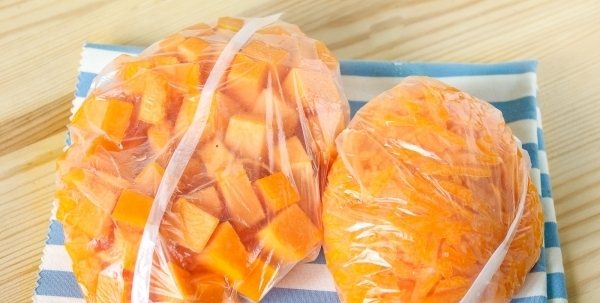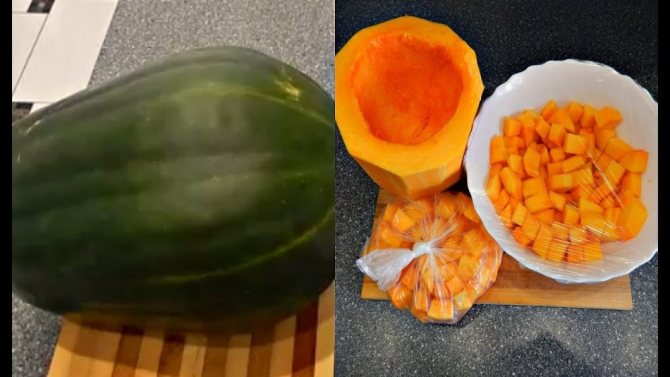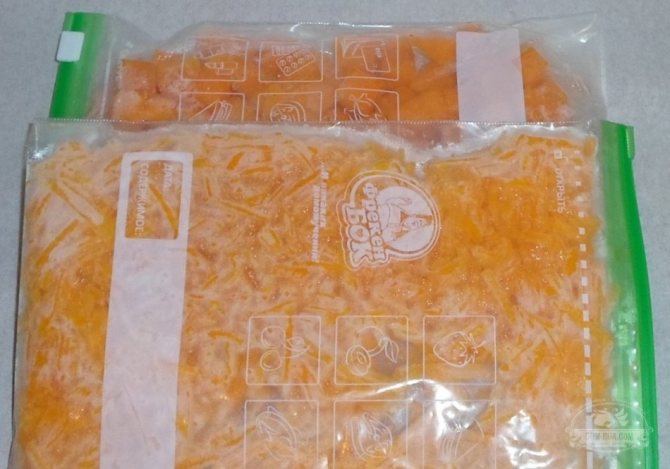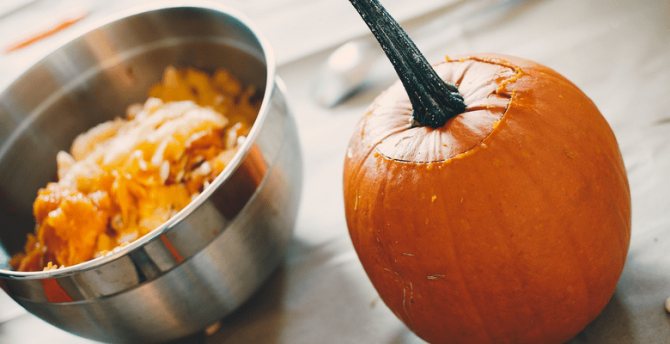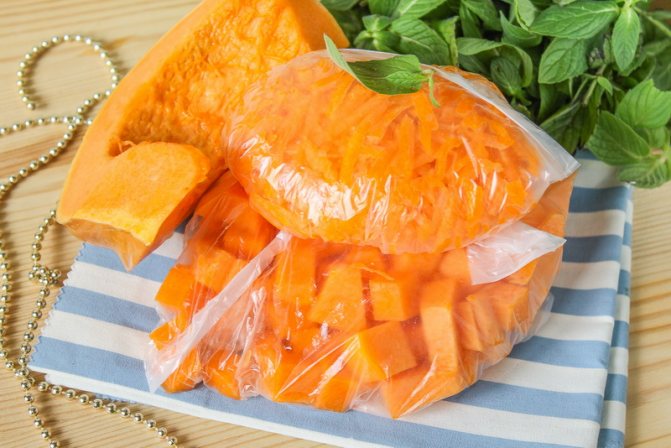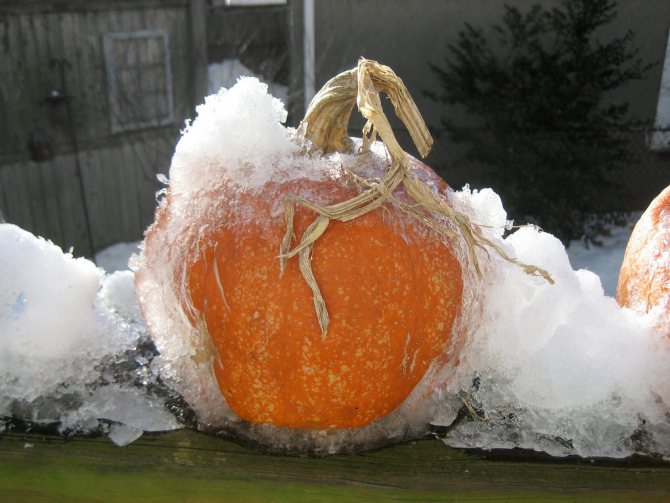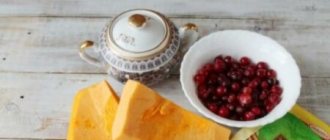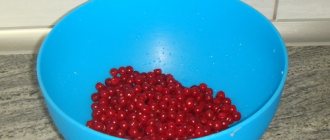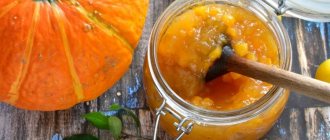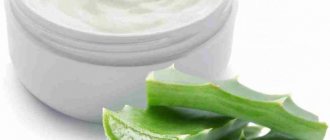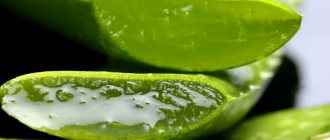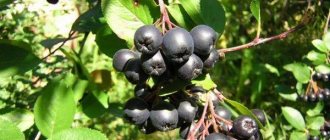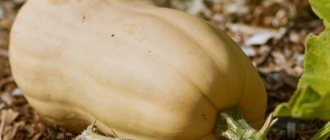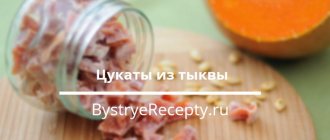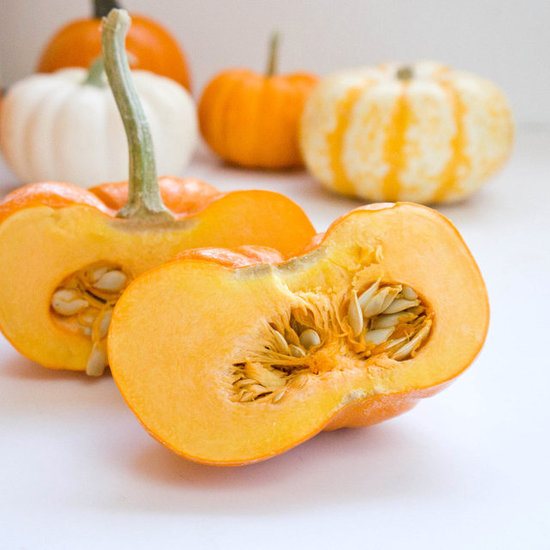
AnyutaN - Sep 15th, 2020 Categories: Freeze
Tags: Frozen pumpkin, Frozen vegetables
The bright beauty pumpkin is always pleasing to the eye. In addition, it is very tasty and healthy. Cutting off a slice from a large juicy pumpkin, you have to think about what to do with the rest of the vegetable. In this regard, many ask questions: "Is it possible to freeze a pumpkin?", "How to freeze a pumpkin?", "How to freeze a pumpkin for a child?" I will try to answer all these questions in this article.
Ingredients: pumpkin Time to bookmark: Summer autumn
How to properly freeze a pumpkin for the winter
It seems that the only difficulty in freezing a pumpkin for the winter in the freezer is to free it from the skin and seeds and cut it into pieces. But after all, as a result, you want to get a ready-made semi-finished product that you can use to prepare various dishes without even defrosting it. Therefore, it is necessary to consider in detail all the nuances of the freezing process.
Pumpkin is rich in nutrients: vitamins, minerals, amino acids, fiber, glucose, fructose and much more. It contains even more protein than poultry eggs, and in terms of carotene content, it is ahead of carrots. And all these nutrients are completely preserved in frozen pumpkin. Only the consistency of the product is lost, after defrosting, pieces of pumpkin can creep and lose their density and elasticity. And then - this applies only to pumpkin, frozen raw.
Advice! So that after thawing the pieces of raw pumpkin would not be too watery, before freezing they are blanched for several minutes in boiling water or dried in the oven for 5-10 minutes.
If the pumpkin is baked or subjected to some other heat treatment before freezing, then both the taste and the consistency of the product will be completely preserved when defrosting.
Freezing is allowed absolutely any kind of pumpkin. It should only be borne in mind that dessert varieties with thin skin are easier to process. On the other hand, it is they who are a little more capricious in storage, so any housewife will prefer to deal with them, first of all.


So that the work on freezing pumpkins for the winter at home is not wasted, you must:
- deal only with fully ripe fruits;
- make sure that they are not damaged, rotten parts.
Regardless of the method of freezing used, the pumpkin must first be washed in cool water. Then cut into 2 halves and scrape out the inner fibrous part where the seeds are concentrated.
Attention! Pumpkin seeds should not be thrown away. After drying, they themselves represent a very healing and nutritious product.
Further actions depend on the selected method of freezing.
How to prepare a vegetable for freezing?
The main thing when harvesting pumpkin for the winter is to choose and prepare a vegetable for freezing. For this, several factors are taken into account:
- You can freeze any kind of vegetable. However, the best varieties are: Acorn, Harlequin, Butternat, Divo, Gribovskaya, Kherson, Gileya, Bylinka, Muscat.
Attention! Summer-grade pumpkins (light and soft) are more suitable for further cooking soups, manti and adding to meat dishes. Winter dense and sugar varieties are more often used for cereals or as a filling in baked goods.
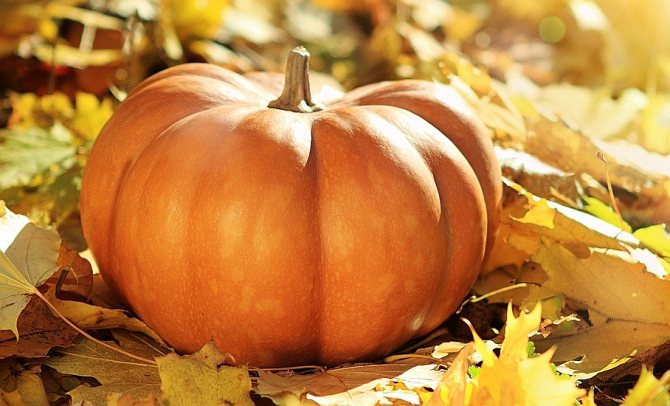

- It is important that the vegetable is ripe, but not overripe.
- Only whole pumpkins are suitable for freezing. Previously cut pieces and slices from the refrigerator, which have been stored for some time, are not suitable for preparation.
- The thick peel should be free from damage, cracks and damaged spots. In this case, the "tail" of the pumpkin should not show signs of decay or damage.
Preparation of the product for procurement is as follows:
- Be sure to rinse the vegetable under running water. Thus, up to 99% of microbes can be removed from the pumpkin surface.
- Cut the vegetable in half with a sharp knife. With a tablespoon, scoop out the fibrous pulp and seeds, leaving only the hard part.
Attention! Don't rush to throw away your pumpkin seeds. Seeds contain 8 of the 12 essential amino acids. By consuming about 100 grams of seeds per day, you can satisfy the body's daily requirement for amino acids.
- Rinse the vegetable again and dry on paper towels.
How to freeze diced pumpkin in the freezer for the winter
Cutting the pumpkin into cubes is the easiest way to freeze a vegetable for the winter. In this form, only raw pumpkin is frozen, so it is necessary, first of all, to free it from the skin. You can do this with a sharp knife, placing half of the vegetable vertically. Or you can use a special peeler if the thickness of the peel allows you to do this.
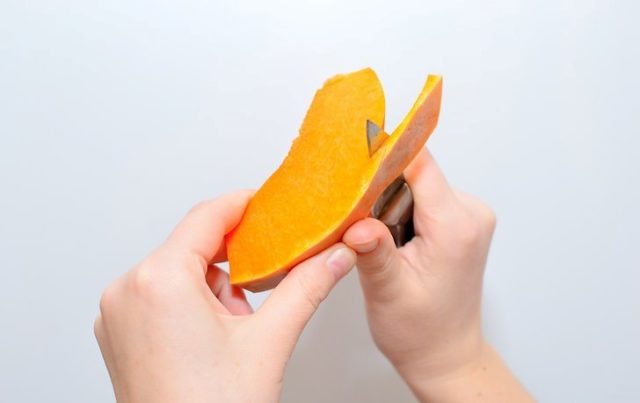

The resulting pulp is first cut into slices, 1 to 3 cm thick, and then into small cubes.
Important! Once thawed, pumpkin cannot be re-frozen - both taste and nutrients will be lost.
Therefore, they take portioned sachets, the size of which is chosen in such a way that their contents can be used at a time. Put pumpkin cubes inside the bags and place them in the freezer. It should be understood that when frozen, the cubes can increase in volume due to the liquid contained in them, therefore, some free space should be left in the bags so that they do not burst.
Small pumpkin cubes (with sides 1-1.5 cm) are ideal for making manti filling, as well as for some desserts. They can also be used without defrosting for pumpkin porridge, vegetable stew, or pie filling.
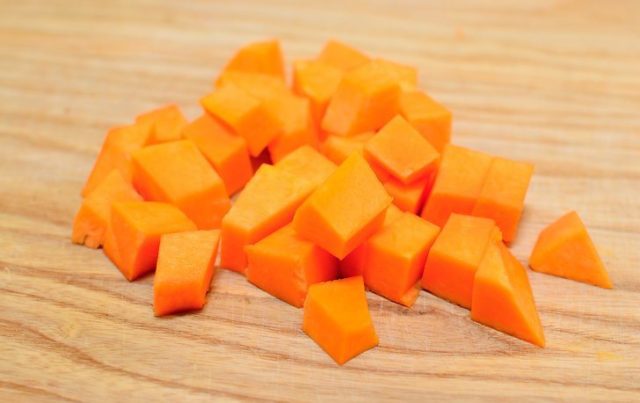

What you need to carve a hard pumpkin
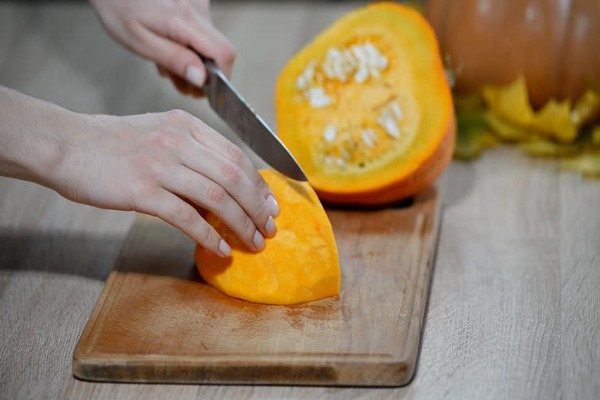

Pumpkin varieties suitable for long-term storage have a rough skin. Sometimes it is hard as a nutshell. When stored for a long time, the peel hardens even more. Peeling such a vegetable is very difficult and requires considerable physical effort. It is especially difficult to cut large-fruited varieties. To cut up hard melon, you need such a kitchen tool:
- cutting board;
- small knife;
- peeler;
- metal spoon or scraper;
- massive knife.
Cutting board and large knife
With the help of a cleaver knife, you can cut the melon in half in one fell swoop. Fibers with seeds are conveniently removed with a metal spoon or scraper. To make it easier to cut the vegetable into pieces, you first need to divide the halves into small chunks. They are cut up or down using a heavy knife. You should act with extreme caution, because sharp melee weapons are easy to injure.
Important!
Before cutting a melon vegetable, you should make sure that its position is completely stable.
The pumpkin is cut on a cutting board. It is chosen by the size of the vegetable. It won't fit on a board that's too small. The fruit must lie completely on a flat surface. For cutting, take a fairly large, thick and heavy board. In this case, the furniture will be reliably protected even if the knife comes off. Do not try to cut the fruit with one hand, holding it tilted or suspended.
Freeze pumpkin cut into large cubes for the winter in the freezer
It is even easier to freeze the pumpkin in relatively large pieces or cubes.The preparation technology is absolutely similar, but here you can no longer pay attention to the correct cutting shape. The size of the blocks can be from 2-3 cm to 8-10 cm in length.
After defrosting, a pumpkin cut into such cubes will necessarily be boiled or stewed with subsequent chopping, so the consistency, shape and size do not matter much.
These sticks are good for making cereals, mashed soups, sautés, stews of meat and vegetables and other side dishes.
Further application
Frozen pumpkin is used for making cereals, soups, first and second courses, salads, sauces and a variety of pastries. Desserts are prepared from an orange vegetable and jelly is cooked. It perfectly complements meat dishes. And for baby food it is simply irreplaceable - it contains many vitamins and minerals that are useful for the growth and development of the baby.
Grated pumpkin, without defrosting, is added to almost ready-made dishes, and pancakes are made from it. When baked, it perfectly complements cereals and side dishes, where it is also added at the end of cooking / frying. Any dish with a bright juicy vegetable will become not only healthy, but also festive.
The pumpkin for complementary foods is frozen both separately and as part of a vegetable mixture. In baby food, it is combined with zucchini, broccoli and carrots. The mixture can be frozen in puree or in small cubes.
Freezing blanched pumpkin for the winter in the freezer
Still, the best way, as mentioned earlier, is to pre-blanch the pumpkin cubes or chunks in boiling water before freezing. Although this method will take a little more time and effort, the taste and texture of the defrosted vegetable will be more attractive.
- After 2-3 minutes in boiling water, the pumpkin pieces are placed in cold water for a couple of minutes, and then on a paper towel to dry.
- After that, the pumpkin pieces are placed on a pallet or baking sheet so as to avoid their contact. Otherwise, it will then be difficult to unhook them from each other.
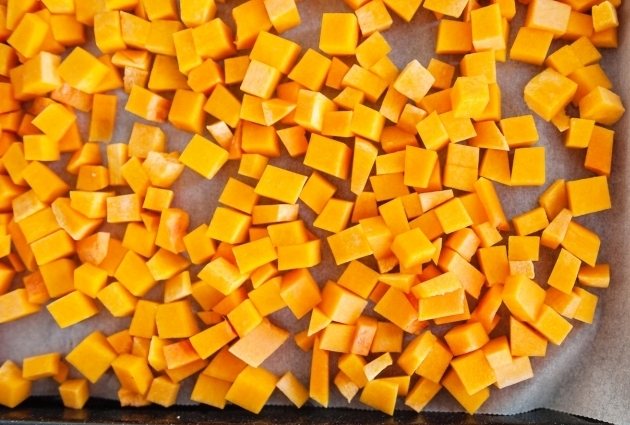

- A baking sheet with cubes is placed in the freezer for a couple of hours to harden.
- After the pieces have hardened, remove the baking sheet and fill the portioned bags with pumpkin cubes, where they will be stored until use.
Advice! It is best to sign packages to avoid confusion between frozen foods.
All of the above dishes can be prepared from such a pumpkin, besides, cubes can be quite tasty in warm salads, casseroles.
How to freeze grated pumpkin for the winter at home
If, after all, there is no desire to mess with blanching a vegetable, then you can find another way to quickly and conveniently prepare pumpkin for freezing for the winter at home.
The peeled pulp can simply be cut into large pieces and grate each of them on a coarse grater or use a food processor for this purpose.
The mashed pumpkin is distributed in portioned sachets, not forgetting to leave a small free space at the top. To make the bags compact in the freezer, they are flattened and placed in the freezer for storage.
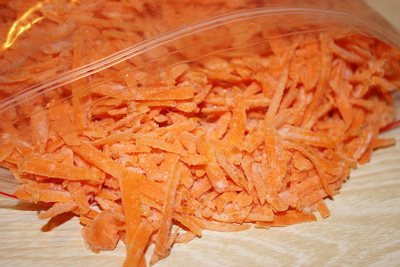

The mashed vegetable can be used to make a pancake. It can be added to dough when baking bread, muffins, cookies and other pastries. Fillings for pancakes, pies and pies, cutlets - mashed pumpkin will come in handy everywhere in these dishes. And lovers of dietary vegetable side dishes and a variety of soups will appreciate the beauty of pumpkin fibers in their signature dishes.
Container and packing
Container plays an important role in long-term storage. Most often, improvised containers are used:
- Plastic containers;
- Polyethylene bags with and without fasteners.
It is possible to use any container of suitable size. When filling mashed potatoes, for convenience, the bag is placed in a plastic bucket, and only then it is filled.Then they release air from the bag, not forgetting to leave a little space, and tie it. Remove from the bucket and flatten the bag. This form promotes rapid freezing and compact storage. Also, for pre-freezing mashed potatoes, use:
- Forms for freezing ice cubes;
- Silicone baking molds;
- Plastic cups.
Freeze pumpkin for the winter in the form of mashed potatoes
According to numerous reviews, the most delicious pumpkin puree for freezing for the winter is obtained from a baked vegetable. For baking, the pumpkin does not even need to be peeled. Simply cut the vegetable into two parts and remove all the seeds. If the fruits are small, then they can be baked directly in halves. Otherwise, each half is cut into several wide slices.
Pumpkin slices or halves are placed in an oven preheated to 180-200 ° C and baked for about an hour. The pumpkin should be soft. After cooling, the pulp is easy to scrape out of the peel with an iron spoon and grind in a blender in a puree.
In the absence of an oven, the pumpkin slices in the peel can be boiled beforehand.
It can be done:
- in boiling water;
- in the microwave;
- over the steam.
In any case, an additional time of about 40-50 minutes will be required. Then the pulp, after cooling, is also easily separated from the peel and turned into puree using a fork, pusher or blender.


Pumpkin puree is best placed in small containers or tins for freezing ice. In this case, they are placed in a freezer, wait for freezing, after which they are removed from molds or containers and transferred to dense plastic bags for storage. This method allows you to obtain, after defrosting, an almost ready-to-eat dish. Therefore, pumpkin puree is put into the dish at the very end of cooking.
Frozen baked pumpkin puree is a great addition to baby's nutrition. It can also be added to a variety of baked goods, made into caviar, cutlets, soufflés and jam. Pumpkin puree is used to make jelly, make a variety of drinks, such as smoothies.
Freezing pumpkin with carrots and zucchini for complementary feeding
For baby food, it is ideal to use frozen vegetable puree, which, after defrosting, only requires heating. After all, you can freeze for the winter not only pumpkin, but also almost any other vegetables.
You can prepare assorted vegetables according to the following recipe:
- Cut the pumpkin into large chunks.
- Wash the carrots, peel and cut off the tail.
- Cut the zucchini into two parts.
- Place vegetables in a preheated oven and bake for about 40 minutes at 180 ° C.
- Cool, separate the pulp from the pumpkin and zucchini, and after mixing them in approximately the same proportion with the carrots, mash in mashed potatoes with a blender.
- Divide the vegetable puree into portioned yogurt cups and place in the freezer.
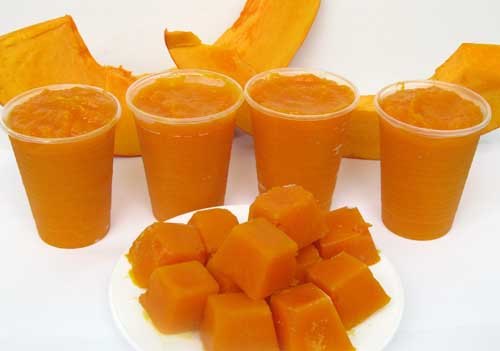

The benefits of pumpkin
Pumpkin is a large and colorful vegetable, which many associate with fertility and autumn harvest. Growing it on the site is easier than ever, but later the question often arises: what to do with it? The main thing is to understand that pumpkin is very useful, it is definitely worth eating. Grown in their own garden, which means it is 100% environmentally friendly, it contains a variety of vitamins - A, C, D, E, B vitamins, the rarest vitamin T, which helps the absorption of food and fights obesity, vitamin K, which is responsible for health blood and bone tissue, and is simply absent in other vegetables.
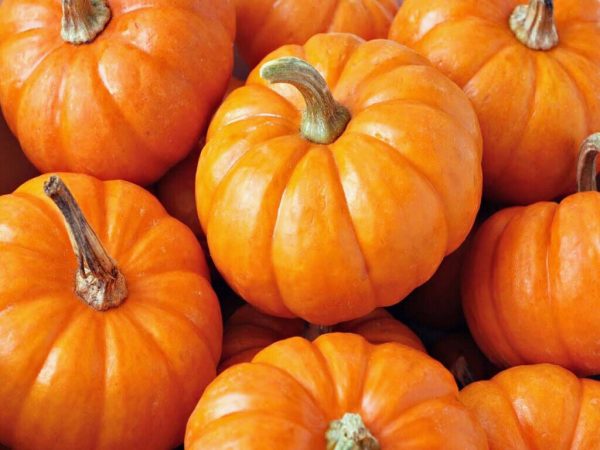

Pumpkin pulp contains a complex of essential vitamins, in particular A, C, D, E, B, T
You can use it in the form of juices and preserves, cereals and casseroles, pies and pancakes, mashed soups and much more. It all depends on your imagination. For some cooking methods, only fresh pumpkin will work, but for most, frozen will work.The useful properties of the vegetable are preserved when freezing and baking, so such a semi-finished product will in no way yield to a fresh product, but it will significantly save time and facilitate the cooking process.
How to freeze pumpkin with sugar for desserts
Pumpkin puree is also convenient because you can add various spices to it even before freezing, thereby determining its further purpose.
For example, by adding 200 g of sugar to 500 ml of mashed potatoes, you can get an almost ready-made dessert that can be used both independently and for preparing almost any sweet dishes.
You can also add salt, black pepper and other spices to the puree to obtain the desired taste, so that you can use it for any savory dishes later.
Some Tips for Making Frozen Pumpkin Meals
For the preparation of most hot dishes, frozen pumpkin blanks do not even require special defrosting.
The pieces are simply placed in boiling water, milk or broth and thus brought to readiness.
The only frozen squash that often needs to be thawed is mashed potatoes. Sometimes it is necessary to defrost grated pumpkin to make the filling. It is best to defrost them in the microwave or refrigerator.
In a freezer at a temperature of -18 ° C, frozen pumpkin can be stored for 10-12 months.
